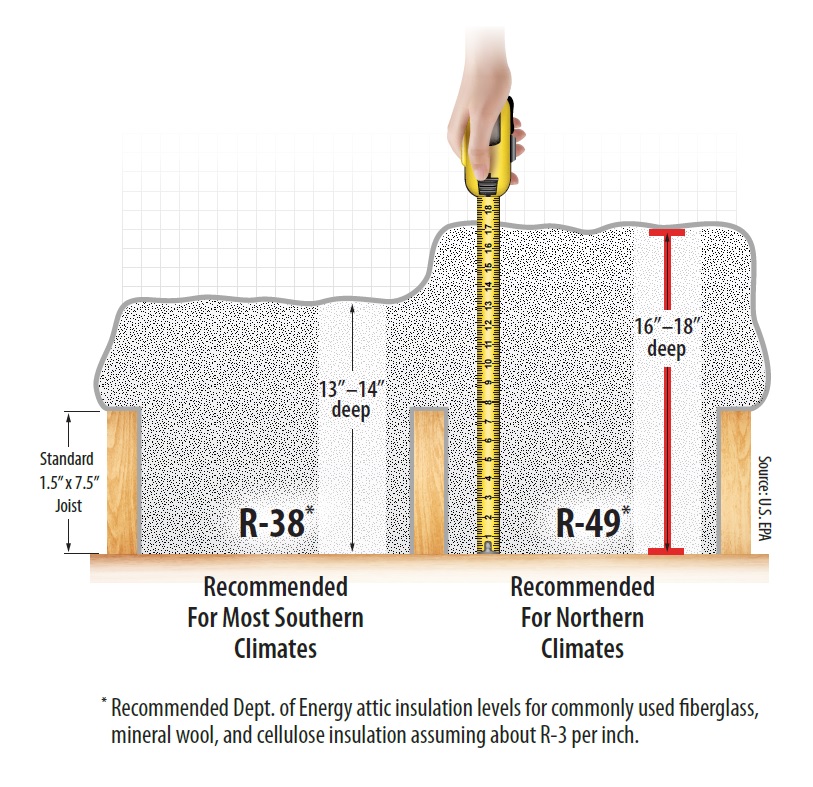Rule Your Attic, Save on Energy Costs

09/14/2020
Temperatures are starting to feel more like fall and before you know it winter will be here. Now’s the perfect time to get your house ready for the cold months ahead. Nine out of 10 homes across America are under insulated, leading to wasted money on utility bills and decreased home comfort. Don’t let your hard-earned money go through the roof. Here’s how you can “rule your attic.”
Do you need more insulation?
Take the first step to energy savings by measuring your attic’s insulation to determine if your attic has enough. Use a tape measure to see how deep the insulation is on your attic floor (see illustration below). You should have 13-14” of insulation if you live in a southern state, and about 16-18” if you live in a northern state. Anything less than that and you may be missing a big opportunity to make your home more comfortable and energy efficient. Tip: if you can see your attic floor joists, you probably don’t have enough insulation. If the existing insulation is dry, mold-free, and uncompressed, you can layer new fiberglass insulation on top to achieve the total amount needed.

DIY or Hire a Pro?
If you find your attic insulation doesn’t measure up, decide if you’d like to tackle the project yourself, or hire a professional. Adding insulation to your attic is a great weekend “Do-it-Yourself” project, but not everyone wants to crawl up into the attic. Contractors typically cost a bit more than doing it yourself, but they can get the job done quickly, safely and have the skills to find any hidden problems, like mold or air leaks.
Insulation Type
There are several types of fiberglass insulation available including batts, rolls and blown-in insulation. Batts and rolls are the best for DIY usage. DIYers can choose to install blown-in insulation using a rented pneumatic machine. Spray foam insulation is another option when insulating your attic. This is a chemical-based insulation that is mixed on site by insulation contractors to create foam and applied with a sprayer. Learn about the differences, including costs, safety and sustainability, between fiberglass and spray foam here.
Tax Credits & Incentives
While adding insulation will help save you money over time, there is the initial cost of the product and installation to consider. To help make your insulation project more affordable, a 10% Federal Tax Credit (up to $500) is available to homeowners before December 31, 2021. Learn if you are eligible for tax credits here. Your insulation improvements may also qualify for state or utility company-based incentives. For a comprehensive list of federal, state and local utility incentives, visit the Database of State Incentives for Renewables & Efficiency (DSIRE).
Benefits Beyond Your Wallet
Not only will attic insulation help you save on your monthly utility bills, you can also feel good about:
- Less pollen, dust and pests entering the home
- Year-round comfort
- Reduced noise from outside
- Boost home re-sale values
- Less energy waste = better for the environment
Ensuring proper insulation in your attic is crucial to achieving an energy-efficient home. Learn more about attic insulation in these how-to videos or at Energystar.gov. Find out where to buy Knauf Insulation here.
DIY Attic Insulation - How to Estimate the Right Amount of Insulation in 3 Easy Steps
DIY EcoBatt Insulation - How to Install Fiberglass Batts to Insulate Attics, Ceilings, Floors and Walls
DIY EcoRoll Insulation - How to Install Fiberglass Rolls to Insulate Attics, Ceilings, Floors and Walls
 WHERE TO BUY
WHERE TO BUY
Find who carries Knauf Insulation products near you.
